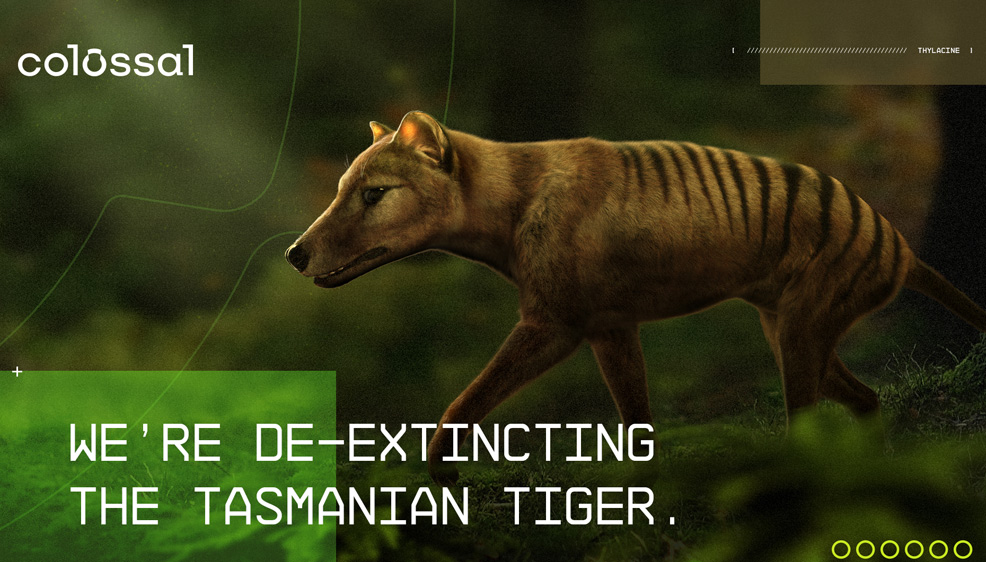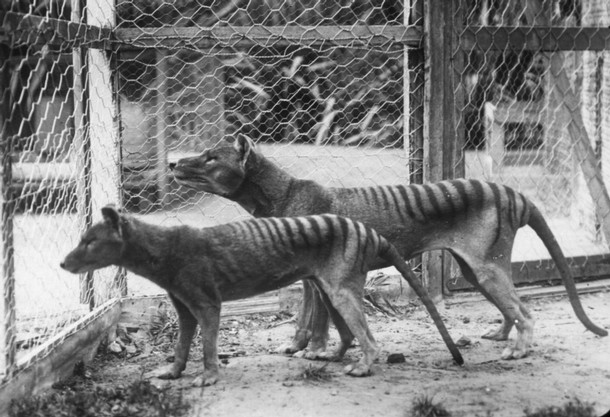
17th August 2022 Scientists plan "de-extinction" of Tasmanian tiger The last known thylacine, also called the Tasmanian tiger, died at Australia's Hobart Zoo in 1936. Now, a team of scientists believe they can resurrect the extinct species within 10 years, using stem cells and gene editing technology.
Colossal Biosciences, a genetic engineering startup company based in Dallas, Texas, has this week announced its plan to de-extinct the thylacine. Noted for its slim and striped appearance, the once common marsupial roamed the Earth for millions of years as a keystone species native to Australasia, including Tasmania and New Guinea. However, human hunting led to a collapsing population and their eradication a century ago. The government had paid its citizens a bounty for every animal killed. In 2017, researchers announced in the journal Nature Ecology and Evolution that sequencing of the full nuclear genome of the thylacine had been achieved, marking a critical first step toward de-extinction. Colossal is now planning to obtain stem cells from a living species with similar DNA – the fat-tailed dunnart – and turn them into thylacine cells, using gene editing. Bringing back the thylacine will not only return the iconic species to the world, but has the potential to re-balance Tasmanian and broader Australian ecosystems, which have suffered biodiversity loss and ecosystem degradation. Research shows Australia has the worst mammalian extinction rate in the world. Without an apex predator, ecosystems plunge into a series of trophic cascades, leading to the spread of disease, an increase in wildfires and invasive species, a reduction in carbon sequestration, and disruption to natural biogeochemical cycles. The thylacine once played a critical role in regulating the ecosystem by hunting non-native mesopredators further down the food chain, which in turn preyed on native herbivores. The disappearance of these native herbivores resulted in harmful changes to natural vegetation and landscapes. This announcement is now the second animal de-extinction project from Colossal, which last year revealed its plans to bring back the woolly mammoth to the Arctic Tundra. Since then, the company has established a team of more than 35 dedicated scientists in three laboratories, from fields including cell engineering, stem cell biology, embryology, computational biology, and genome engineering. Colossal is now assembling an expert thylacine team and is nearing completion of its new dedicated thylacine laboratory. Following its official launch in September 2021, a total of $75m has been raised in funding over two rounds. Colossal has partnered with the University of Melbourne and its Thylacine Integrated Genetic Restoration Research Lab, which is headed by Andrew Pask, PhD, leading marsupial evolutionary biologist and the world's foremost Tasmanian tiger expert. He brings a wealth of knowledge on marsupial gestation and evolution.
"We're thrilled to be collaborating with Andrew Pask and the University of Melbourne to restore this amazing animal to Earth, while also further developing gestational and genetic rescue technologies for future marsupial conservation efforts," said Ben Lamm, Colossal Co-Founder and CEO. "With our planet's biodiversity at risk, we will continue to contribute scientific resources to preserving the species and ecosystems necessary to sustain life." "This is a landmark moment for marsupial research and we're proud to team up with Colossal to make this dream a reality," said Dr. Pask. "The technology and key learnings from this project will also influence the next generation of marsupial conservation efforts. Additionally, rewilding the thylacine to the Tasmanian landscape can significantly curb the destruction of this natural habitat due to invasive species. The Tasmanian tiger is iconic in Australian culture. We're excited to be part of this team in bringing back this unique, cornerstone species that mankind previously eradicated from the planet." The successful birth of a thylacine requires new, marsupial-specific assisted reproductive technologies, to use the stem cells to make an embryo, for transfer into either an artificial womb or a dunnart surrogate to gestate. This technology could be instrumental in the preservation of marsupials at large, which are highly concentrated on Australia, the country with the fastest rate of biodiversity loss. The team at Colossal believe they can develop it within 10 years. "Andrew and his lab have made tremendous advances in marsupial research, gestation, thylacine imaging, and tissue sampling," said Colossal Co-Founder and world-recognised leader in genomics, Dr. George Church. "Colossal is excited to provide the necessary genetic editing technology and computational biology to bring this project, and the thylacine, to life. It's an incredible collaboration with far-reaching benefits for animal conservation efforts at large." The rewilding of species to their original habitats has been shown to effectively restore and revitalise damaged ecosystems, with examples such as the reintroduction of wolves to Yellowstone, and the Tasmanian Devil (a close relative of the thylacine) to Australia. Although rewilding any species is a long and layered process, the creation of a proxy species of the thylacine has the potential to similarly restore ecosystems that are missing keystone species.
Comments »
If you enjoyed this article, please consider sharing it:
|








